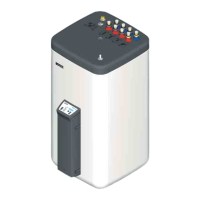22
FA ROTEX Solaris RPS4 - 06/2015
6 x Control
– Achieving the maximum storage tank temperature set via
parameter "T
S
max" (T
S
indicator flashes). In this case,
restarting the solar operating pump P
S
is only possible if the
storage tank temperature has fallen by more than 2 K.
– Achieving the maximum permissible solar panel temperature
(T
K
-light flashes) set using the parameter "T
K
perm". In this
case, restarting the solar operating pump P
S
is only possible
if the solar panel temperature has fallen below the parameter
value "T
K
perm" by more than 2 K.
– Faulty FlowSensor.
6.2.2 Booster function for high solar panel
temperatures
From a solar panel temperature of "T
K
max" = 70 °C (booster
temperature), the output of the solar operating pump P
S
is
increased in steps.
Î This increases the system pressure as well as the flow
quantity, which enables more heat to be stored within a
shorter time.
The booster temperature can be changed by the heating expert
using the parameter "T
K
max". This increase in output is switched
off again automatically if the booster temperature falls by 5 K.
6.2.3 Start optimisation
Start optimisation prevents too frequent cycling and reduces the
power consumption. This is a self-inhibiting function (activated in
the factory).
The switch-on condition (see section 6.2.1) is supplemented by a
variable constituent (VAR):
DT on + VAR >= T
K
- T
R
.
With the function activated, the current spread TV - TR is as-
sessed after the filling time (parameter "Time P2"). The existing
value of VAR is updated based on this measurement. Three
cases must be differentiated:
– If the spread is above the top limit OG
VAR
, VAR is reduced
by the step size ¨VAR.
Î The next filling thus starts at a lower temperature differ-
ence T
K
- T
R
.
– If the spread is below the bottom limit UG
VAR
, VAR is
increased by the step size ¨VAR.
Î The next filling thus starts at a higher temperature differ-
ence T
K
- T
R
.
– If the spread is between the threshold values, the current
value of VAR is retained.
6.2.4 Switch-on block functions
The switch-on block functions prevent:
– switching on again if, because of reaching the set maximum
storage tank temperature "T
S
max" the solar system has been
automatically switched off (T
S
light flashes).
– pump operation with activated "intensified frost protection
function" (star symbol flashes in the display -
see section 6.2.11).
– Pump operation, if the solar panel temperature exceeds the
adjustable value set by the heating expert by parameter
"T
K
zul" (T
K
indicator flashes).
After switching off the solar operating pump P
S
as a result of the
maximum storage tank temperature, continuing impingement of
the sun's rays on the solar panel can cause temperatures of over
100 °C. If the storage tank temperature falls below the release
temperature ("T
S
max" – 2 K), (e.g. by the removal of hot water),
the solar operating pump P
S
is only switched on again if the tem-
perature at the solar panel falls below the value set with the pa-
rameter "T
K
perm" of the set restart protection temperature by
2 K.
The function blocking time ensures that the solar operating pump
P
S
is only released again, after the occurrence of a switch-off
condition, after expiry of the blocking time (0 - 600 secs.) set in
the parameter "Time SP".
This means:
– the cycling of the solar system can be minimised.
– the solar panel can achieve a higher temperature.
– when filling the solar system, the flow temperature does not
fall below the switch-off condition and the system regulates
itself more quickly.
6.2.5 Pump kick function
During extended shut-down periods, the solar operating pump P
S
is activated for a few seconds every 24 hours.
This prevent s the solar operating pump from seizing up.
If there is active frost protection (T
K
<0 °C within the last
24 h) there will be no rapid switch-off. The solar operat-
ing pump P
S
is operated for an extended period, so that
the connecting lines are heated up to such a tempera-
ture that does not permit the formation of ice plugs.
In this case, however, a considerably higher solar panel
temperature must be achieved before the solar oper-
ating pump P
S
switches on.
If the solar operating pump P
S
is switched on at solar
panel temperatures over 100 °C (T
K
perm > 100 °C), the
return water vapourises as soon as it reaches the solar
panel. The dissipation of the thermal over-capacity in
the solar panels and the associated boiling noises cre-
ated by vapourisation can last for several minutes.
The water vapour escapes in a depressurised manner
into the solar storage tank in a correctly installed solar
system, where it condenses again to a large extent. A
slight increase in the consumption of buffer water,
caused by the escaping unpressurized water vapour, is
a normal operating condition.

